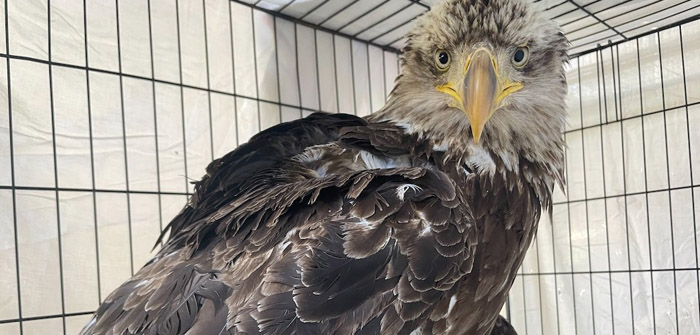(Photo courtesy of Think Wild)
Think Wild received the eagle on Sunday, May 12, after a community member saw the bird on the ground in their pasture for a few days. The rescuer noticed the bird could not fly well when approached, so they carefully contained the bird in a crate for transport to Think Wild.
Think Wild admitted the 7.4-pound juvenile bald eagle and performed an intake exam. Upon intake, the eagle tested positive for lead toxicity at 53.8 micrograms per deciliter (ug/dL), over five times what is considered clinical in wild raptors (10 ug/dL). Think Wild staff will treat the bald eagle with injectable chelation therapy over the next few weeks. The chelating agents bind to the lead molecules in the eagle’s blood, allowing it to move through and out of the bird’s body. Chelation therapy alone costs over $300 per treatment.
So far, the eagle is perching, self-feeding, and resistant to handling, which are all positive signs. There are persistent symptoms of lead toxicity as well – the eagle is lethargic and exhibits wing and head drooping when resting. As the chelating agents remove the lead from the eagle’s system, we hope to see an improvement in these neurologic symptoms.
Raptors found with lead poisoning are said to have “lead intoxication.” They may appear “drunk,” with balance and coordination issues, lethargy and wing droop. Symptoms can also include leg paralysis, muscle wasting, dehydration, and anemia. The vast majority of lead-poisoned eagles don’t survive, and oftentimes those that are found must be humanely euthanized due to irreversible organ, muscle, visual, bone and brain damage.
Lead from ammunition is the primary source of lead toxicity in many species, like bald eagles, due to whole bullets or fragments left behind in live prey, gut piles, and carcasses.* It is likely that the eagle recently fed on a carcass or prey animal that contained fragmented lead ammunition. Raptor lead toxicity increases during hunting season as gut piles or unrecovered game contaminated with lead are ingested by eagles, raptors, corvids and many other species, resulting in multiple food chain toxicities. Eagle nests near farms and agricultural areas can also be susceptible to toxic lead accumulation when lead shot is used for pest control, as adults may feed poisoned rodents to their nestlings.
In the last three years, Think Wild has treated over twenty birds of prey, including golden and bald eagles, turkey vultures, and Cooper’s hawks, for lead toxicity. Only four of those patients were releasable back to the wild. Director of Wildlife Rehabilitation Pauline Hice says, “Lead poisoning is an unfortunate occurrence that rehabilitators across the US see regularly due to the use of lead ammunition, lead sinkers, and environmental contamination. Luckily, these cases are preventable.”
People can prevent lead poisoning in wildlife by using non-lead ammunition, fishing sinkers and rodent control. If you choose to use lead, bury dressing piles and keep the lead away from any sources of water. If you see an eagle or any bird with symptoms of lead intoxication, please contact Think Wild’s Wildlife Hotline at 541-241-8680.
Do not attempt to capture or offer food and water to injured wildlife without first contacting a licensed professional. Bald eagles are protected in the United States by the Migratory Bird Treaty Act and the Bald and Golden Eagle Act.
*Pain DJ, Mateo R, Green RE. Effects of lead from ammunition on birds and other wildlife: A review and update. Ambio. 2019 Sep;48(9):935-953. doi: 10.1007/s13280-019-01159-0. Epub 2019 Mar 16. PMID: 30879267; PMCID: PMC6675766.


